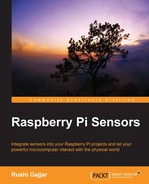Book Description
Integrate sensors into your Raspberry Pi projects and let your powerful microcomputer interact with the physical world
In Detail
The tiny Raspberry Pi device contains the power to revolutionize the way we understand computing. Built with a Linux-based operating system, it is a tool that invites exploration and experimentation, and can be repurposed and integrated with other hardware and software to help create some truly exciting projects.
With Raspberry Pi Sensors you will learn how to get more from your Raspberry Pi and dive deeper into its engineering by exploring its Linux-based OS before learning how to develop and execute programs on it using Python and C. You'll then find a range of projects like creating your own ultrasonic sensor to monitor the atmosphere, connect your Raspberry Pi to the Internet so you can upload data online and use it as a launchpad to create Internet of Things based projects. Learn how to create your own image sensor using a simple USB camera and the innovative OpenCV library to perform motion detection.
What You Will Learn
- Set up your Raspberry Pi board and integrate it with powerful sensors
- Discover how to operate your Raspberry Pi by exploring its Linux-based OS
- Develop a deep understanding of your Raspberry Pi's GPIOs and access them through Python, C, and shell scripting
- Create an ultrasonic distance meter and use it to make an aid for visually impaired or blind people
- Interface a temperature-humidity sensor and photocells together with your Raspberry Pi to log the data
- Find out how to upload the data you collect online and receive regular notifications of irregularities
- Integrate OpenCV with your Raspberry Pi and learn how you can master the latest in image processing technology with the power of computer vision
Downloading the example code for this book. You can download the example code files for all Packt books you have purchased from your account at http://www.PacktPub.com. If you purchased this book elsewhere, you can visit http://www.PacktPub.com/support and register to have the files e-mailed directly to you.
Table of Contents
- Raspberry Pi Sensors
- Table of Contents
- Raspberry Pi Sensors
- Credits
- About the Author
- Acknowledgements
- About the Reviewers
- www.PacktPub.com
- Preface
- 1. Meeting Your Buddy – the Raspberry Pi
- A glance at the Raspberry Pi board
- Setting up for the first time
- Connecting the Raspberry Pi to the Internet
- A crash course on Linux
- Installing useful libraries
- python-gpio
- Be ready with Python and C
- Practice makes you perfect
- Summary
- 2. Meeting the World of Electronics
- 3. Measuring Distance Using Ultrasonic Sensors
- 4. Monitoring the Atmosphere Using Sensors
- 5. Using an ADC to Interface any Analog Sensor with the Raspberry Pi
- 6. Uploading Data Online – Spreadsheets, Mobile, and E-mails
- 7. Creating an Image Sensor Using a Camera and OpenCV
- A. Shopping List
- Index
